In this article, we will discuss one of the most fascinating and threatened big animals, magnificent but fragile cheetah, with experts listing concerns for Cheetahs. They are renowned for their lightning speed and gracefulness. However, experts are concerning about the future of these majestic animals. Therefore, this article will cover prospective conservation measures to protect cheetah populations from the different threats they face.
Leading conservationist Valmik Thapar expressed concerns about “how the big cat will walk, hunt, feed, and bring up its cubs” in Kuno National Park in Madhya Pradesh, where it faces “a lack of space and prey,” on the same day that eight cheetahs were brought in from Africa as part of a historic re-establishment of the animal in India.
“The main adversaries of the cheetah are leopards and hyenas, which are abundant in this region. He claimed in an interview that hyenas hunt and sometimes even kill cheetahs in Africa’s region.” There are 150 nearby villages with dogs that can rip cheetahs apart. It’s a highly kind creature.
Physiological Characteristics Of The Cheetah
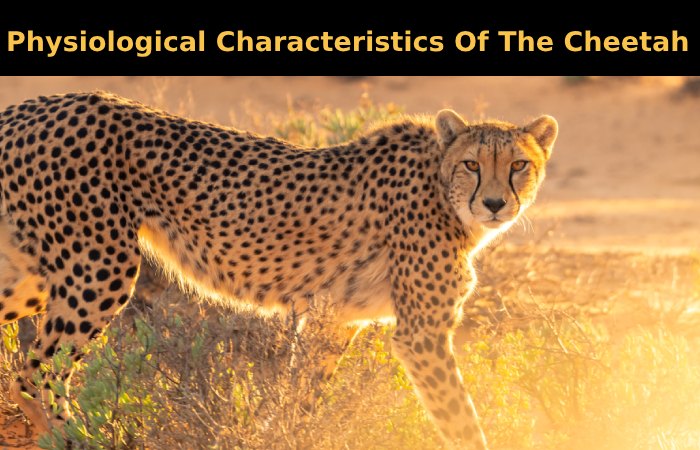
The world’s fastest land animal is a cheetah, with a top speed of 113 kilometers per hour. They can reach this incredible speed thanks to their physiological traits.
- Body structure: Cheetahs have long, slender bodies with long legs and deep chests. This body shape allows them to run with great speed and agility.
- Muscles: They have controlling muscles in their legs and back. These muscles allow them to generate the force needed to run at high speeds.
- Blood: Cheetahs have a high absorption of red blood cells in their blood. Red blood cells carry oxygen, which helps cheetahs get more oxygen to their muscles.
- Heart and lungs: Cheetahs have a large heart and lungs. These organs allow them to circulate blood and oxygen throughout their body rapidly.
- Respiration: They can breathe in and out much faster than other animals. It lets them take in more oxygen, which is essential for running at high speeds.
- Tail: Cheetahs have long tails, which help them balance running at high speeds.
- Claws: Cheetahs have semi-retractable feet. These claws help them to grip the ground when running rapidly.
These physiological characteristics make cheetahs to be the fastest land animals on Earth. They use their speed for hunting prey, and their speed is also a vital defense mechanism.
Speed VS Space Of Cheetah
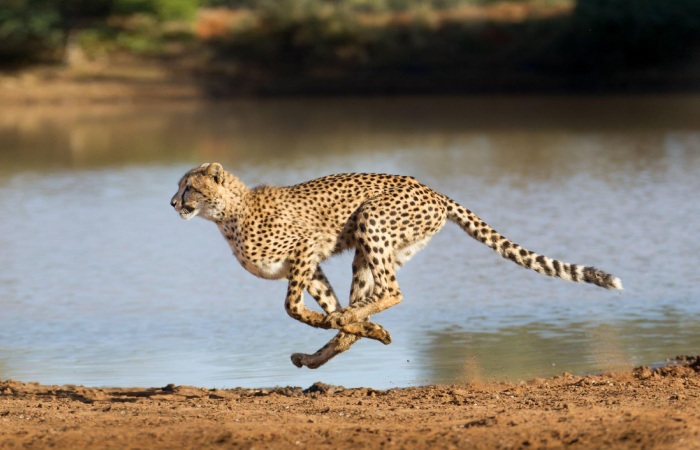
Asked why the cheetah, the fastest mammal on earth, couldn’t just outrun its attackers, he cited the difference in terrain. “In places like the Serengeti (National Park in Tanzania), cheetahs can run away because there are large expanses of grassland. However, in Kuno, unless you convert woodland to grassland, it’s a problem; quickly turning corners on stony ground, full of obstacles, is a huge challenge (for the cheetahs).”
Mr. Thapar listed the tiger as another potential threat to the cheetah in Kuno: “Sometimes even tigers come here from Ranthambore, one of the reasons why lions could not be relocated. That’s not often. But we will have to enfold that corridor too.”
What Will Cheetah Eat?
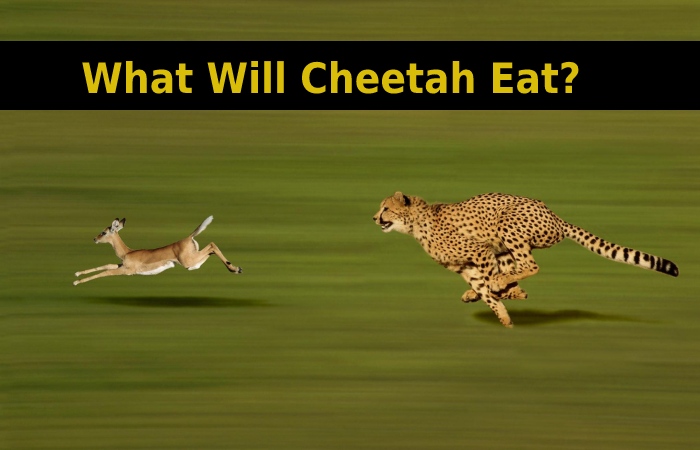
- He also listed out difficulties in finding prey. “In the Serengeti, there are about a million-plus gazelles accessible. So in Kuno, except we breed and bring in blackbucks or chinkaras, which live on grassland, the cheetahs will have to kill and eat the Spotted Deer, which are forestry animals and can hide. But unfortunately, these deer also have huge antlers and can injure the cheetah. And cheetahs cannot afford injury; it’s mostly fatal for them.”
- “We needed to breed chinkaras and blackbucks already. Yet we want to make history,” he said, “I am not sure why we are enterprising this at this level. There are a lot of problems with indigenous species. We need to find a balance.” He said the cheetah has extensively been a “royal pet” and has “never hunted a human being. Cheetah is so magnificent, so fragile. [The relocation] is a huge challenge.”
In India, that species was declared extinct in 1952. They struggle with reproduction, as Valmik Thapar emphasized. Only 6,500 to 7,100 remain in existence worldwide. Additionally, 95% of cubs die at this stage, which is the mortality rate. Eight have been added for now, and over time, there will be an increase to 35. It is an enormous task. They must be watch over constantly to make sure they’re alive.
Additional Experts List Concerns For Cheetahs: Magnificent But Fragile
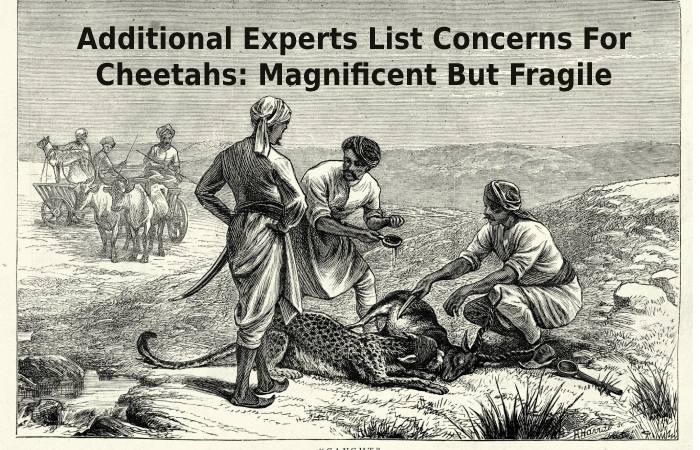
The loss of their native habitat due to human activities like farming and urban development is one of the main issues cheetahs are currently experiencing. Because of habitat destruction, cheetah populations are declining, making obtaining food and home more difficult.
- Cheetahs frequently encounter human conflict when humans encroach upon their habitats, particularly farmers and livestock owners. Farmers who kill cheetahs to safeguard their livestock may contribute to the species extinction.
- Cheetahs are frequently the target of poachers due to the high value of their skin in the black-market wildlife trade. As a result of their capture and sale as exotic pets, cheetah populations continue to dwindle, and cubs are lying open to unnecessary misery.
- Cheetah populations have experienced a genetic bottleneck, leading to a lack of genetic diversity. Because of this lack of diversity, the species is more likely to experience health problems, including illness.
- As a result of climate change, ecosystems, and weather patterns are changing, creating new challenges for cheetahs in their quest for adequate habitats and prey. The threats currently faced by cheetah populations and the species serving as their food source may worsen due to climate change.
Efforts For Cheetah: Magnificent But Fragile
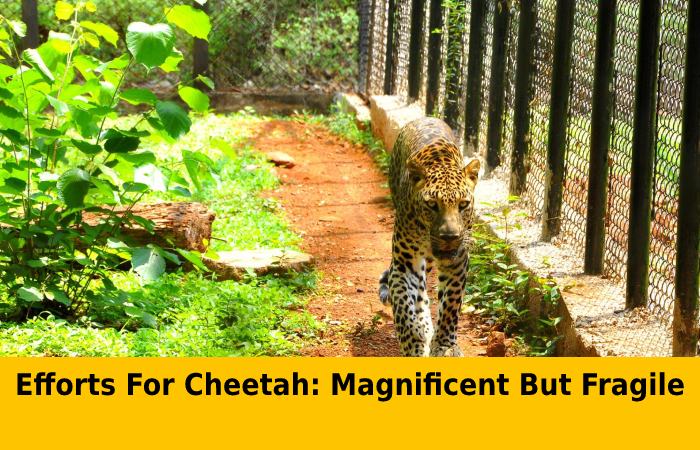
The preservation and restoration of cheetahs’ natural habitats can help protect their populations. It may be vital to reforest degrading landscapes, use sustainable land management techniques, and create protected areas. Thus, to guarantee that cheetahs have access to enough territory and prey.
- Involving and educating local populations is essential for the survival of cheetah conservation efforts. Teaching people about cheetahs and their place in the ecosystem can promote understanding and cooperation. Funding community-based conservation programs is also a viable option to encourage locals to safeguard cheetahs and their habitats.
- They are protecting cheetahs from being killed for their skin and cubs by strengthening efforts against poaching and cracking down on the illegal wildlife trade. The international community, law enforcement, and wildlife transportation monitoring systems can accomplish this together.
- Studying and keeping tabs on cheetah populations’ genetic diversity can aid conservation efforts and lessen the damage caused by genetic bottlenecks. The long-term survival of cheetahs depends on keeping their gene pool as diverse as possible.
- Justifying the effects of climate change on ecosystems is crucial for the survival of cheetahs and other endangered species. We can lessen the impact of climate change on cheetah habitats and their prey by encouraging clean energy. Moreover, lowering greenhouse gas emissions, and bolstering climate-resilient ecosystems.
- Cheetah populations are increasing through translocation and reintroduction initiatives by reintroducing them to areas where they have gone locally extinct or to new habitats. Such programs’ rigorous design and monitoring are essential to the long-term survival of the reintroduced cheetah populations.
- Governments, NGOs, scientists, and communities worldwide are working together to save the cheetah. However, to ensure the cheetah’s continued existence, all parties concerned must collaborate to devise and implement effective ways to safeguard the animal and its habitats.
Some Of The Establishments That Are Working To Help Cheetahs: Cheetah Magnificent But Fragile
- The Cheetah Conservation Fund: This fund is a non-profit organization that saves cheetahs. The CCF works to protect cheetahs through various projects, including creating protected areas, combating poaching, and reducing conflict with humans.
- Combating poaching: Poaching is a significant threat to cheetah populations. By strengthening law enforcement and informing people about the value of cheetahs, conservationists are attempting to combat poaching.
- Reducing conflict with humans: Cheetahs sometimes prey on livestock, leading to conflict with farmers. Conservationists are working to reduce friction between cheetahs and humans by compensating farmers for livestock losses and teaching farmers how to deter cheetahs from preying on their animals.
- Conducting research: Scientists are researching more about cheetahs and the threats they face. This research can help environmentalists raise better ways to protect cheetahs.
- Raising awareness: The public should know the threats cheetahs face and the importance of protecting them. It can complete through education and outreach programs.
- The Wildlife Conservation Society: This Society is a non-profit organization that saves wildlife and wild places. For example, the WCS works to protect cheetahs through various projects, including conducting research, raising awareness, and supporting protected zones.
- The International Union for Conservation of Nature: They work to conserve nature as an international organization. For example, the IUCN lists cheetahs as a “Vulnerable” species, which means they are at risk of extinction. The IUCN works to protect cheetahs through various projects, including developing conservation plans and raising awareness.
Conclusion
Cheetahs, as gorgeous as they are, are on the verge of extinction due to climate change, human-wildlife conflict, poaching, and genetic bottlenecks. They can, however, make it with consistent conservation efforts. We can assure the long-term survival of this iconic species through habitat preservation, community involvement, anti-poaching measures, genetic monitoring, climate change mitigation, translocation schemes, and international cooperation.
Hence, Cheetah as magnificent and fragile must be saved because they are critical to environmental health. As governments, conservation organizations, academics, and local communities collaborate to discover effective ways to address these majestic but fragile species’ dangers, their future looks brighter.
Related posts
Featured Posts
What Is A Web Project? – Phases For Planning, and More
Introduction Web Project The term ” web project ” can designate different development types, including technical creation, content management, data,…
10 Benefits of Eating Roasted Gram
In this article, we will talk about the 10 benefits of eating roasted gram. The roasted gram is also known…


